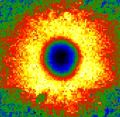Speaker
Description
Janus 2D TMD is formed by two different chalcogen atoms on each side of the TMD (represented as Janus XMY, where M = transition metal; X = chalcogen at the bottom; Y = chalcogen at the top), and due to this out-of-plane break mirror symmetry and electronegativity difference between top and bottom layers, Janus TMD has internal perpendicular electric field, which leads to a variety of novel physical phenomena. In this study, we investigated the dependence of the Janus SWSe (J-SWSe) with number of layers during the sulfurization process. Using the Chemical Vapour Deposition (CVD) approach, we were able to utilize $H_2$S gas as a source of sulphur and sulfurize $WSe_2$ that was previously mechanically exfoliated on the MEMS chip. Raman Spectroscopy analysis revealed that vibrational modes $A_1g$ and $E_2g^1$ of $WSe_2$ were modified, however, there are no peak related the J-SWSe for monolayer and bilayer. This result indicates that the top Se atoms were partially substituted for these structures, generating an intermediate state. Vibrational mode related to the J-SWSe was recognized only three staking layers, which suggested that out-of-plane vibration ($A_1g$) and VdW force can help the J-SWSe formation.

